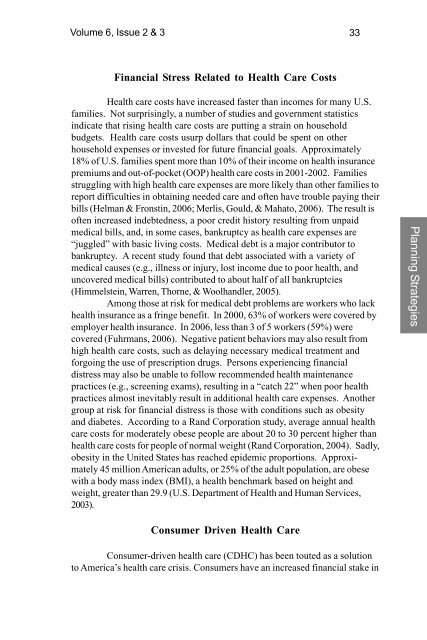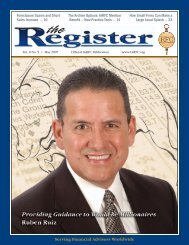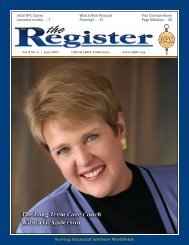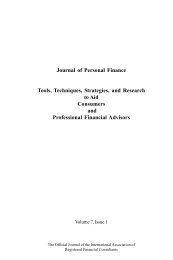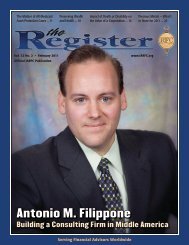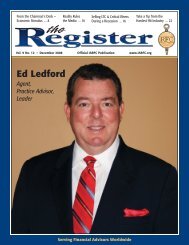3433-vol. 6 issue 2-3.pmd - iarfc
3433-vol. 6 issue 2-3.pmd - iarfc
3433-vol. 6 issue 2-3.pmd - iarfc
Create successful ePaper yourself
Turn your PDF publications into a flip-book with our unique Google optimized e-Paper software.
Volume 6, Issue 2 & 3 33<br />
Financial Stress Related to Health Care Costs<br />
Health care costs have increased faster than incomes for many U.S.<br />
families. Not surprisingly, a number of studies and government statistics<br />
indicate that rising health care costs are putting a strain on household<br />
budgets. Health care costs usurp dollars that could be spent on other<br />
household expenses or invested for future financial goals. Approximately<br />
18% of U.S. families spent more than 10% of their income on health insurance<br />
premiums and out-of-pocket (OOP) health care costs in 2001-2002. Families<br />
struggling with high health care expenses are more likely than other families to<br />
report difficulties in obtaining needed care and often have trouble paying their<br />
bills (Helman & Fronstin, 2006; Merlis, Gould, & Mahato, 2006). The result is<br />
often increased indebtedness, a poor credit history resulting from unpaid<br />
medical bills, and, in some cases, bankruptcy as health care expenses are<br />
“juggled” with basic living costs. Medical debt is a major contributor to<br />
bankruptcy. A recent study found that debt associated with a variety of<br />
medical causes (e.g., illness or injury, lost income due to poor health, and<br />
uncovered medical bills) contributed to about half of all bankruptcies<br />
(Himmelstein, Warren, Thorne, & Woolhandler, 2005).<br />
Among those at risk for medical debt problems are workers who lack<br />
health insurance as a fringe benefit. In 2000, 63% of workers were covered by<br />
employer health insurance. In 2006, less than 3 of 5 workers (59%) were<br />
covered (Fuhrmans, 2006). Negative patient behaviors may also result from<br />
high health care costs, such as delaying necessary medical treatment and<br />
forgoing the use of prescription drugs. Persons experiencing financial<br />
distress may also be unable to follow recommended health maintenance<br />
practices (e.g., screening exams), resulting in a “catch 22” when poor health<br />
practices almost inevitably result in additional health care expenses. Another<br />
group at risk for financial distress is those with conditions such as obesity<br />
and diabetes. According to a Rand Corporation study, average annual health<br />
care costs for moderately obese people are about 20 to 30 percent higher than<br />
health care costs for people of normal weight (Rand Corporation, 2004). Sadly,<br />
obesity in the United States has reached epidemic proportions. Approximately<br />
45 million American adults, or 25% of the adult population, are obese<br />
with a body mass index (BMI), a health benchmark based on height and<br />
weight, greater than 29.9 (U.S. Department of Health and Human Services,<br />
2003).<br />
Planning Strategies<br />
Consumer Driven Health Care<br />
Consumer-driven health care (CDHC) has been touted as a solution<br />
to America’s health care crisis. Consumers have an increased financial stake in


